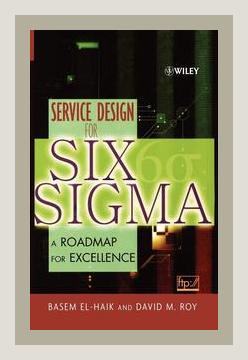Operations and Supply Chain ManagementService Operations
Title: Service Design for Six Sigma: A Roadmap for Excellence
Authors: Basem El-Haik, David M. Roy
Category: Service Operations
Introduction
“Service Design for Six Sigma: A Roadmap for Excellence” by Basem El-Haik and David M. Roy is a comprehensive guide that integrates the methodologies of Six Sigma with the nuances of service design to create superior service offerings. The book provides both theoretical frameworks and practical tools, enriched with numerous examples, to help service organizations achieve excellence. It is especially valuable for service managers, designers, and Six Sigma practitioners.
1. Understanding Six Sigma in Service Design
Major Points:
– Six Sigma is a method focused on improving quality by identifying and removing the causes of defects and minimizing variability in processes.
– Applying Six Sigma to service design enhances customer satisfaction by creating efficient, cost-effective, and high-quality service processes.
Action:
– Conduct Six Sigma training for your team to ensure they understand and can apply its principles to your service design processes.
Example:
– An airline used Six Sigma to analyze and improve their check-in process, leading to reduced waiting times and enhanced customer satisfaction.
2. Service Strategy Development
Major Points:
– Developing a service strategy involves understanding customer needs, assessing competitive benchmarks, and aligning services with organizational goals.
– A robust service strategy should be customer-focused and data-driven.
Action:
– Use Voice of Customer (VoC) techniques to gather and analyze customer feedback to shape your service strategy.
Example:
– A healthcare provider implemented VoC surveys to identify patient needs and redesigned their appointment scheduling system, resulting in faster service and higher patient satisfaction.
3. Design for Six Sigma (DFSS) Methodology
Major Points:
– DFSS is a systematic approach to designing products and services that meet customer expectations and have minimal defects.
– It involves five key phases: Define, Measure, Analyze, Design, and Verify (DMADV).
Action:
– Implement the DMADV approach in your next service design project to ensure a structured and efficient design process.
Example:
– A financial services company used DMADV to design a new online banking platform, focusing on user interface and security, which led to a significant increase in customer adoption and satisfaction.
4. Tools and Techniques in Service Design for Six Sigma
Major Points:
– Various tools such as QFD (Quality Function Deployment), FMEA (Failure Modes and Effects Analysis), and Pugh Matrix are essential for designing robust services.
– These tools help in translating customer needs into technical requirements and identifying potential failures.
Action:
– Use QFD in your service design meetings to prioritize customer requirements and ensure they are addressed in the final service design.
Example:
– A hotel chain used QFD to redesign their guest services, focusing on key customer needs like cleanliness and prompt response, resulting in higher guest satisfaction scores.
5. Implementing Service Design Projects
Major Points:
– Successful implementation involves project planning, team collaboration, and rigorous testing of service designs.
– Pilot testing and iterative refinement are crucial to ensure the service meets customer expectations before full-scale deployment.
Action:
– Develop a detailed project plan with milestones and conduct pilot tests to refine your service design based on feedback.
Example:
– An IT support firm tested their new helpdesk system with a small group of users and used the feedback to improve the system before rolling it out company-wide.
6. Measuring Service Performance
Major Points:
– Measuring performance involves setting Key Performance Indicators (KPIs) and using Six Sigma metrics such as DPMO (Defects Per Million Opportunities) and Sigma Level.
– Regular performance reviews help in identifying areas for improvement and ensuring service quality.
Action:
– Define KPIs for your services and regularly monitor them using Six Sigma metrics to maintain high service standards.
Example:
– A call center established KPIs such as average call handling time and first call resolution rate, and used Six Sigma to continually improve these metrics.
7. Sustaining Service Excellence
Major Points:
– Continuous improvement is essential for sustaining service excellence. Organizations should foster a culture of quality and innovation.
– Regular training, maintaining up-to-date process documentation, and encouraging employee engagement are critical components.
Action:
– Establish a continuous improvement team and conduct regular training sessions to keep your staff updated on best practices and new tools.
Example:
– A retail chain implemented a continuous improvement program where employees were encouraged to suggest improvements, leading to a 20% increase in operational efficiency.
Conclusion
“Service Design for Six Sigma: A Roadmap for Excellence” is an invaluable resource that equips service organizations with the methodologies and tools to achieve high-quality service delivery. By integrating Six Sigma with service design, businesses can enhance customer satisfaction, reduce costs, and ensure sustained excellence. Through concrete examples and actionable strategies, El-Haik and Roy present a clear roadmap for service excellence.
Action Plan Summary:
- Conduct Six Sigma training to build a foundational understanding within your team.
- Use VoC techniques to gather and analyze customer feedback.
- Implement the DMADV approach for structured service design.
- Utilize QFD in design meetings to prioritize customer needs.
- Develop a detailed project plan and conduct pilot tests.
- Define and monitor KPIs using Six Sigma metrics.
- Establish a continuous improvement team and conduct regular training.
By following these steps, service organizations can harness the power of Six Sigma to design, implement, and sustain superior service offerings, leading to a competitive advantage and long-term success.
